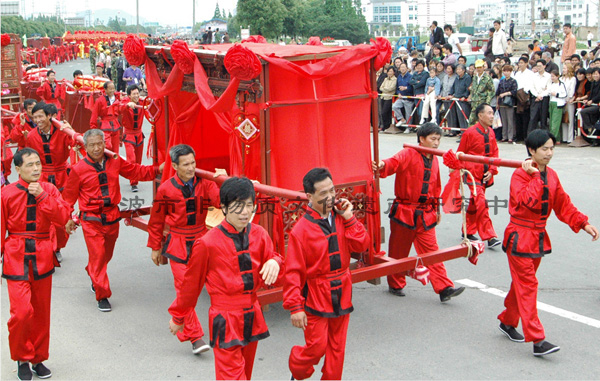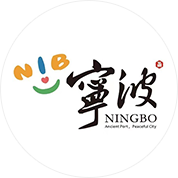
"Ten-Mile Bridal Procession". (Photo by Ningbo Intangible Cultural Heritage Protection Centre)
The ancient legend serves as the foundation for the formation of the Ninghai "Ten-Mile Bridal Procession" wedding custom. This tradition is not only a unique wedding ritual in Ninghai and eastern Zhejiang but also a significant folk event celebrating marriage.
A well-known legend in Ninghai recounts that Emperor Gaozong of the Song Dynasty, Zhao Gou, was once pursued by Jin soldiers to the western countryside of Ningbo. A village girl hid him under a winnowing basket on the threshing ground, deceiving the soldiers. After his rescue, the emperor revealed his identity and promised, “When my reign stabilises, I will invite you to the palace to repay your kindness.” As proof, he took her stomacher.
The following year, when the emperor sent envoys to find her, news leaked. Every household in the village hung a stomacher at their door, making it impossible to identify the true saviour. Unable to fulfil his promise, the emperor issued a decree: “All women in eastern Zhejiang shall be granted royal status.”
Henceforth, brides could enjoy princess-like privileges: wearing a phoenix coronet and embroidered cape, and possessing dowries carved with dragons and phoenixes. Thus, the wedding customs of eastern Zhejiang gained legitimacy for brides to receive royal treatment—half an imperial procession, the phoenix coronet and cape, and lavishly carved dowries—growing increasingly extravagant over time.
The dowry procession stretched for miles, vividly described by locals as the “Ten-Mile Red Dowry.” This phrase eventually became synonymous with grand weddings, symbolising formally arranged marriages and evolving into a cultural event celebrated across villages.
The Ninghai "Ten-Mile Bridal Procession" custom encompasses engagement rituals, matchmaking, dowry preparation, bridal procession, sedan chair reception, ceremonial rites, wedding festivities, and the unique craftsmanship of red dowry items. Iconic elements like the “thousand-hour bed” (a bed requiring thousands of hours of work), the “ten-thousand-hour sedan chair” (a sedan chair demanding immense labour), and the Ten-Mile Red Dowry are emblematic nuptial traditions in eastern Zhejiang, passed down through generations. The dowries showcase the pinnacle of Jiangnan craftsmanship, with vibrant red symbolising joy, fortune, and passion, embodying the region’s cultural heritage.
Though modern lifestyles and foreign influences have diluted this tradition, Ninghai’s villages still preserve their essence. While not as complete as before the mid-20th century, elements like the bridal sedan chair, dowry trunks, red chamber pots, quilts, furniture, eggs, couplets, and double-happiness symbols remain visible. Amidst Western cultural influences, this ancient custom faces the risk of fading, yet its legendary origin continues to drive its preservation.
Core Concept
“Affluent families dowry their daughters lavishly, ordinary families gift modestly, impoverished families sell their daughters.” To avoid the stigma of “selling” a daughter, families spared no expense in dowry preparation. This intricate process began on an auspicious date, involving artisans like carpenters, sculptors, lacquerers, coopers, and tailors. Essential dowry items included the bridal bed, red wardrobes, dowry chests, clothing racks, dressing tables, large foot-washing tubs, ceremonial trays, and the “fertility pot” (red chamber pot symbolising descendants).
On the wedding day, the groom’s procession arrived at the bride’s home. By afternoon, the dowry procession and bridal party would journey to the groom’s residence. Led by a boy carrying the chamber pot, the vibrant parade—centred around the bridal sedan—featured carriers and bearers amid dazzling displays of joy. Weddings were grand affairs, meant to demonstrate prestige and familial pride. Affluent families showcased dowry processions stretching miles, filled with everything from sewing kits to exquisitely carved furniture and brassware, each chest and barrel brimming with treasures. Even the chamber pot held red eggs, symbolising fertility, particularly the birth of sons.
Amid thundering drums, firecrackers, and music, the procession radiated celebration and opulence. As the focal point, the bride in her sedan chair, adorned in red and green finery, created memories unforgettable to all who witnessed it.
Source: Ningbo Intangible Cultural Heritage Protection Center
Editor: Ye Ke



